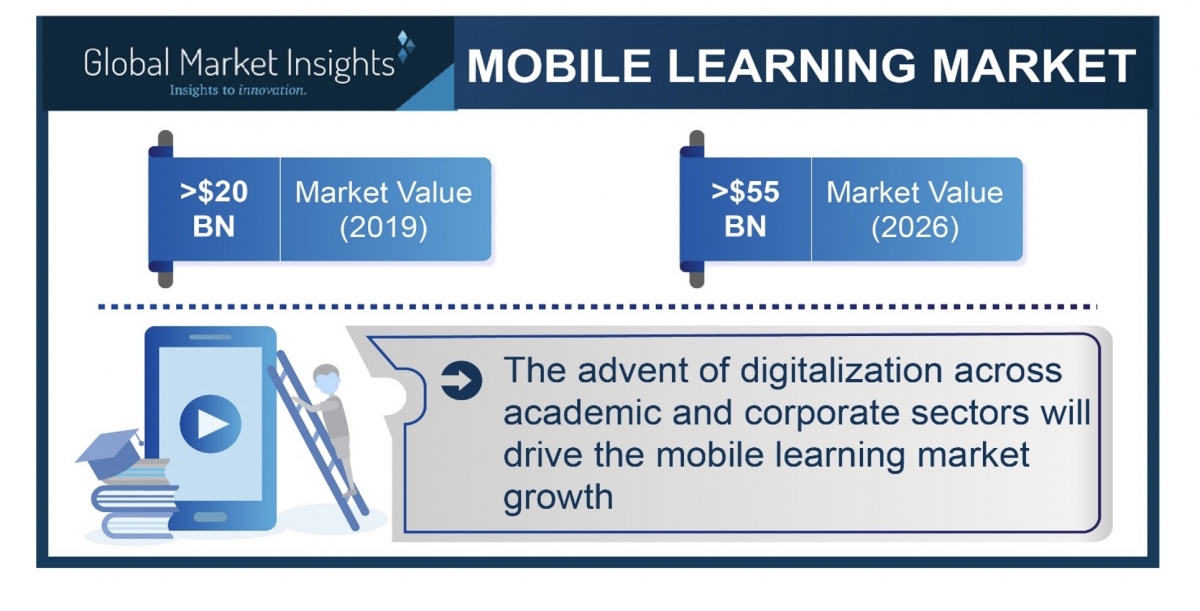The mobile learning market is set to grow from its current market value of more than $20 billion to $55 billion-plus by 2026, according to the latest study by Global Market Insights, Inc.
This expected expansion is attributed to the rising number of mobile device and smartphone users, emergence of various e-learning content providers, and technological advancements. Mobile learning, also referred as m-learning, is a novel way to access learning content by using mobile devices.
The mobile learning market is bifurcated in terms of:
- Solutions
- Providers
- Applications
- Regional landscapes
With respect to solutions, the mobile learning market is classified into m-enablement, interactive assessments, mobile and video-based courseware, portable learning management system (LMS), e-book, and others. Among these, the portable LMS segment will witness substantial growth over the coming years. Strategic alliances with LMS solution providers are a dominant strategy between content developers. These strategic alliances add extra value to the content and provide strong tracking capabilities, which are easier to scale and manage.
The interactive assessments segment is slated to witness robust growth over the coming years. Mobile learning system refers to the interactive and simulative process of teaching and learning with the use of mobile devices and applications, instead of the conventional classroom method. Mobile learning further integrates the techniques and knowledge of the classroom with the flexibility and scalability of advanced mobile technology, thereby creating a unique, fruitful, and efficient learning experience. These features will further boost the segmental growth.
The ongoing Coronavirus pandemic will significantly fuel the demand for mobile learning solutions. With educational institutions conducting lectures online and companies resorting to remote working techniques to ensure social distancing, the mobile learning market will continue to gain traction in near future. International organizations, such as the World Health Organization (WHO), are also adopting mobile learning technology to help healthcare workers. The WHO Academy’s mobile learning app developed specifically for healthcare workers offers training resources that educate them to protect themselves from the virus while treating COVID-19 patients.

Based on provider, the mobile learning market is categorized into content and service. Among these, the content provider segment will experience tremendous growth opportunities over the coming years. Mobile learning providers offer content on a diverse range of topics, often by teaming up with domain experts who help them develop learning content. In fact, they focus on delivering specific, as well as customized content, according to end-user needs. Some prominent providers of e-learning content providers include Kineo, Infopro Learning, AllenComm, and SweetRush.
In terms of application, the overall mobile learning market is segmented into government, corporate, and academic. Among these, the government application segment is likely to witness robust growth over the coming years. In recent years, several government administrations across the world have revolutionized the industry through digitalization.
Government enterprises are encouraging the integration of advanced economic development, as well as social welfare techniques. For example, e-learning is one of the main projects developed by Canada’s Ministry of Education, providing students more choices to effectively customize their respective education according to their interests, strengths, and needs.
From a regional frame of reference, mobile learning with mobile phones has high potential across Latin America. According to World Bank, approximately 87 percent of Latin Americans own a mobile phone. Likewise, the availability of mobile bandwidth has increased significantly over the last few years.
According to Global Market Insights estimates, smartphones currently represent approximately 68 percent of overall network connections. Nearly 76 percent of the Latin American population will have mobile bandwidth available soon. In addition, fast proliferation and regular use of cellular phones make them essential tools that have low adoption barriers and are easy to integrate. These factors will substantially drive the demand for m-learning across the Latin American region.
For more information, visit: https://www.gminsights.com/industry-analysis/mobile-learning-market




